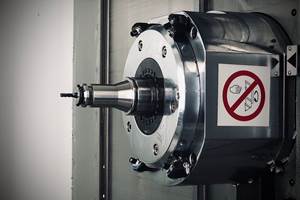Dedicated Tapping Machine Optimizes Cell For Milwaukee Manufacturer
As a heavy user of CNC machine tools, Harley-Davidson is a model for applying high-tech manufacturing techniques. Yet, when a machining cell needed an efficiency boost recently, the answer came from a decidedly less-complex, dedicated hole-tapping machine.
Share






As a heavy user of CNC machine tools, Harley-Davidson is a model for applying high-tech manufacturing techniques. Yet, when a machining cell needed an efficiency boost recently, the answer came from a decidedly less-complex, dedicated hole-tapping machine.
The machine is an automated leadscrew tapper built by Hypneumat, Inc. (Franklin, Wisconsin). During the first three months of use, Harley-Davidson was able to increase hole productivity from two to three minutes per part, to only about ten seconds per part. And scrap due to tapping has been entirely eliminated.
In doing so, the total part production in the cell rose 33 percent, from six parts per hour to eight parts per hour. Running two shifts per day, that accounts for 32 additional parts per day.
Careful readers will have noticed that the increase in part productivity is disproportionate to the increase in hole-tapping efficiency.
According to Tom Romoser, Sr., the manufacturing engineer who is currently in charge of the cell, "That was anticipated. Right now the Hypneumat machine is outpacing our other efforts in the cell. This gives us the opportunity to optimize production flow for even greater cell efficiency in the future."
The basic advantage of a dedicated machining approach is the use of special, low-cost equipment, optimized to do just one task exceedingly well. The value of more expensive CNC machinery, by contrast, is flexibility. The optimum use of a CNC machine is to per-form as many different tasks as possible on as many different kinds of parts as possible.
That is exactly what was needed in the Harley-Davidson cell, which produces inner-primary housings for several of Harley-Davidson's popular motorcycles.
Raw aluminum castings arrive at the cell for milling, spot facing, drilling, tapping, reaming and boring operations. One operator loads and unloads two large CNC machining centers which handle the bulk of these operations through a 32-minute duty cycle per part group, with four parts in a group.
As parts come off the individual machining centers, the operator prepares them for tapping operations on 14 holes. Two of these holes require 5/16-18 taps, while the other 12 use 1/4-20.
Previously, the holes were tapped one at a time on a twin-head, manual drill press. It took considerable operator skill to anticipate the correct feed rate with one hand, while positioning the part with the other. Predictably, even the best operators had problems occasionally, resulting in broken taps and scrapped parts.
Today, the Hypneumat automated tapping machine taps all 14 holes at the same time, in one, quick cycle, at the press of the twin palm feed buttons.
To accomplish this, the Hypneumat was outfitted with a multiple-spindle drill head. This drill head features a rectangular, universal joint configuration that delivers accurate hole alignment through a metal template that can be changed according to job requirements.
Hypneumat's distributor for the Milwaukee-based Harley-Davidson facility, Industrial Drilling Systems, was instrumental in engineering the proper machine/drill head design specification to exactly meet the tapping requirements.
The head attaches to the quill on the Hypneumat machine, which delivers rapid approach and retract, with feed controlled precisely through the spindle by a leadscrew cartridge that can be changed according to job requirements.
An unusual feature of the machine is its ten-inch stroke, which is significantly more than what was available in other models.
Ron Newman, manufacturing engineer, explains, "We wanted the extra stroke so that our operator would have plenty of clearance to load and unload parts, without worrying about nicking the soft aluminum surface.
"It cost more for that extra stroke length, but we figured we'd make it up on fixturing time. It would take considerably more time to fixture the part with shorter stroke and proportionately smaller work envelope."
In addition, the company finds that no taps have been broken and no parts have been scrapped since going on-line with Hypneumat. The tapped holes are also said to be more consistent in accuracy.
"The real winners in all of this, however, are our customers," says Mr. Newman. "The new Hypneumat automatic tapper gives us headroom for additional productivity gains that will help us control cost for many years to come. MMS
Related Content
Briquetting Manufacturer Tools Up for Faster Turnaround Times
To cut out laborious manual processes like hand-grinding, this briquette manufacturer revamped its machining and cutting tool arsenal for faster production.
Read MoreIndexable Drill Heads Double Profitability
Moving to a robust line of indexable drills enabled this shop to dramatically alter the manufacturing process for a problem part, doubling its profitability.
Read MoreHow to Troubleshoot Issues With Tool Life
Diagnosing when a tool is failing is important because it sets an expectation and a benchmark for improvements. Finding out why gives us a clue for how to fix it.
Read MoreThe Future of High Feed Milling in Modern Manufacturing
Achieve higher metal removal rates and enhanced predictability with ISCAR’s advanced high-feed milling tools — optimized for today’s competitive global market.
Read MoreRead Next
Machine Shop MBA
Making Chips and 91ÊÓƵÍøÕ¾ÎÛ are teaming up for a new podcast series called Machine Shop MBA—designed to help manufacturers measure their success against the industry’s best. Through the lens of the Top Shops benchmarking program, the series explores the KPIs that set high-performing shops apart, from machine utilization and first-pass yield to employee engagement and revenue per employee.
Read MoreAMRs Are Moving Into Manufacturing: 4 Considerations for Implementation
AMRs can provide a flexible, easy-to-use automation platform so long as manufacturers choose a suitable task and prepare their facilities.
Read More



















